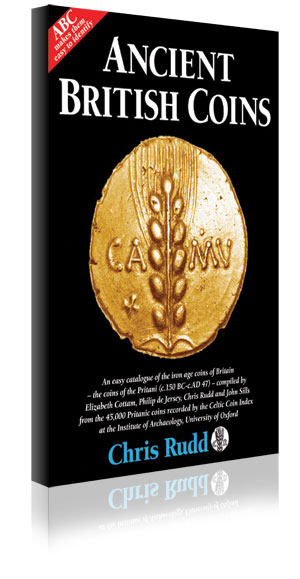 A big new Celtic catalogue with 2000 twice-size coin photos A big new Celtic catalogue with 2000 twice-size coin photos
An easy catalogue of the iron age coins of Britain– the coins of the Pritani (c.150 BC-c.AD 45) – compiled by Elizabeth Cottam, Philip de Jersey, Chris Rudd and John Sills from the 45,000 Pritanic coins recorded by the Celtic Coin Index at the Institute of Archaeology, University of Oxford
Never before have so many ancient British coins been so easy to identify, so easy to study, so easy to enjoy. Ancient British Coins catalogues 999 iron age coins, including 418 new types not shown by Van Arsdell in 1989. Ancient British Coins describes and dates them, gives up to six references for each, estimates their rarity and shows every coin twice actual size, so that its distinctive differences can be seen at a glance. ABC took
ten years to produce, has 256 fact-packed pages and contains 4000 superb coin photos, plus 500 other illustrations, diagrams, tables and maps.
Ancient British Coins is a picture book, not a lecture book. "ABC is a remarkable achievement" says Prof. Miranda Aldhouse-Green. "It manages to combine scholarship and accessible information in a volume whose every page is interesting and whose writing style makes it fun to use." ABC is a large hardback book (30 x 20 cm), light in style, heavy in weight (1.5 kgs) - "an indispensable aid to anyone wanting to identify British iron age coins" says Prof. Colin Haselgrove - worth every penny of its £75 POST FREE
INDEPENDENT BOOK REVIEW:
As the study of ancient British coins has expanded from slow beginnings and with publication and re-interpretation adding to our knowledge, so the mountain of information has grown. It has often been said that we stand on the shoulders of the giants who preceded us, and this is indeed true of the pioneers in the study: Sir John Evans, Derek Allen, Commander Mack, Clem Lister, etc. It is by following their initial guidance and thoughts, taking note of and interpreting new finds, that Chris Rudd and Liz Cottam have been able to produce the incredible publication, Ancient British Coins. This, like many other authoritative publications, will become known as and referred to simply by its initial letters, ABC, and will remain an indispensable reference work for many years to come.
The book has been designed to be very user friendly, despite its large size (29x21 cms) – it is no pocket book to be used in the field. It is divided into three major parts, the first of which is introductory material presenting the pioneers, outlining the origins of the coinage, the Gallic imports, and detailing the major issuing areas (with maps and typical coins). Part Two begins by explaining how the catalogue has been put together. The coins are all shown at twice actual size for ease of recognition, and each has a unique name and ABC number, and an ‘area date code’ (e.g. EA5 = Kent, c. 60-50 BC). The coin’s unique name in the listing is followed by its denomination and metal, a short description and references to the six main catalogue sources (many coins, of course, not being found in a number of them, and indicated by a dash). Dates for the majority of the coins necessarily are speculative. Additional information might include the coin’s Celtic Coin Index number, or an indication of rarity. For coins that can be ascribed to specific rulers some very useful information is provided, what (if anything) is known about them and relevant publications. The catalogue of the British coins (excluding the listing of the Gallic imports) occupies pages 33 to 143 and includes various small box-presented explanatory notes on specific aspects of interest
Part Three, headed "Other helpful stuff”, really is just that. An ABC fact identifier illustrates the coins in their metal order of gold, silver and bronze, referring back, via its number, to the main listing. Interesting essay are located here on The Celtic Coin Index; Ancient British Coins in the British Museum; The Portable Antiquities Scheme (PAS), and indexes to significant British kings and tribal names, and a very useful four-way concordances between ABC numbers, Van Arsdell, British Museum, and Spink Standard Catalogue numbers. The highly detailed in-depth Bibliography covers 18 double-column pages.
This has been designed as a very visual and user-friendly book. There is no question that although the book will be very large and difficult to fit on the book shelves, and also an initial hefty investment in buying it, for anyone who is interested in or involved with ancient British coins, this is worth its proverbial weight in gold. It is a magnificent source book that will hold the field for a very long time.
Peter A. Clayton
|




